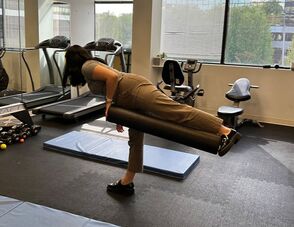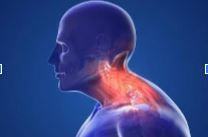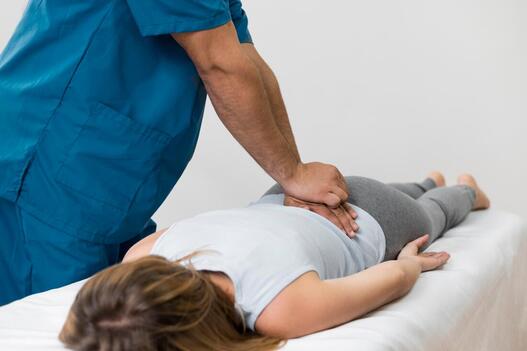 Phase II Exercise: Single Leg RDL with foam roller assist Phase II Exercise: Single Leg RDL with foam roller assist What are the “hamstrings”? The hamstrings are a bundle of three separate muscles: semimembranosus, semitendinosus, and biceps femoris. All three of them are located on the back of the thigh. The main action of these muscles is to bend, or flex, the knee as well as internally rotate and adduct the leg. Injuries to this muscle group are extremely common unfortunately, and can happen to individuals of all activity levels; however 29% of sports injuries can be classified as hamstring strain injuries. Usually people will feel the onset of pain while running or sprinting and can hear or feel an audible pop. Bruising is also not uncommon depending on the severity of the strain. These injuries are very susceptible to a risk of reinjury, so it’s essential to determine the true cause of the injury. Whether it be due to a muscle imbalance with the quadriceps, or a lack of flexibility and strength. Little evidence exists to show that over the counter anti-inflammatory medications are beneficial as well. Low level laser therapy, and working on the appropriate rehabilitation plan can provide long-term effects. With rehabilitation the goal is to address the biomechanical dysfunction that led to the initial injury. Eccentric strengthening has been shown to be the most effective at reducing re-injury. Eccentric contractions occur when the muscle is being activated while also lengthened at the same time. In addition to eccentric strengthening of the hamstrings, working on core and lumbo-pelvic stability and balance should be a focal point. The initial phase of rehabilitation begins immediately after the injury and can last for four weeks. In this phase regular activity should be modified to reduce extraneous stress on the tissue, however movement and mild exercise can prevent full atrophy and decreased neural drive. In this phase exercises will be geared towards range of motion and include mainly open-kinetic chain movements. The second phase of rehabilitation aims to restore maximal strength contractions with pain-free repetitions. This second phase can last for several weeks. The third, and final, phase includes dynamic and advanced exercises to re-establish athletic movements in full capacity. The overall prognosis of hamstring strain injuries is very good as long as the appropriate rehabilitation is performed. Phase I Exercises
Phase II Exercises
Phase III Exercises
-Danirose Billings
0 Comments
 A Dowager's hump, also known as kyphosis or hyperkyphosis, refers to an excessive outward curvature of the upper spine, resulting in a rounded hump-like appearance in the upper back and neck. While reversing a Dowager's hump entirely is not always possible, there are measures individuals can take to improve posture, strengthen muscles, and potentially reduce the prominence of the hump. The best medicine of course would be the avoidance of developing such a hump in the first place. A hyperkyphosis can lead to other significant problems such as headaches, neck pain, numbness/tingling, spinal stenosis, disc herniations/bulges, spinal degeneration and arthritis. Prevention and Management Strategies 1. Posture Correction:
 Image by pressfoto on Freepik Image by pressfoto on Freepik In our quest for optimal health and wellness, we often focus on nutrition, exercise, and mindfulness practices. However, there's one crucial aspect of wellness that is sometimes overlooked: chiropractic maintenance care. Chiropractic care isn't just for alleviating pain; it's a cornerstone of preventive healthcare that can unlock a host of benefits for both body and mind. Chiropractic care is founded on the principle that proper alignment of the spine is essential for the body to function optimally. Through adjustments and other manual techniques, chiropractors aim to restore alignment, relieve pressure on nerves, and facilitate the body's natural ability to heal itself. While many people seek chiropractic care to address specific issues like back pain, neck pain, or headaches, maintenance care takes a proactive approach. Rather than waiting for symptoms to arise, individuals engage in regular chiropractic visits to maintain spinal health and prevent future problems. Just as we service our cars regularly to prevent breakdowns, our bodies also benefit from routine maintenance. Here's why regular chiropractic care is so vital:
If you're new to chiropractic care or considering incorporating maintenance visits into your wellness routine, here are a few tips to get started:
TEXT or call 203-842-88502 to schedule your chiropractic "tune-up" today! |
The Norwalk Sports & Spine Blog is for answering your questions! Stay tuned to learn about our practice, health, food, treatments, and more!Subscribe for updates! Categories
All
Archives
April 2024
|



 RSS Feed
RSS Feed